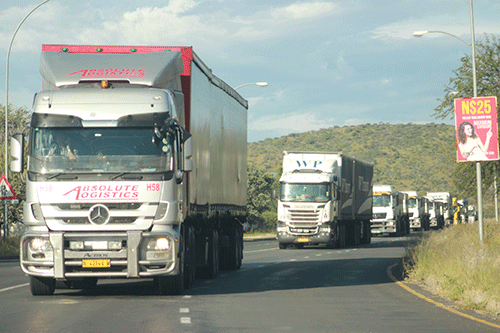Namibians reacted furiously at yet another increase in the price of diesel.
“Diesel is the backbone of the economy, this means everything will go up. All trucks transporting food run on diesel. Food prices will include the mark-ups for transport in the supermarkets or small shops. People will suffer to buy food. What kind of decisions are these? So, the fuel that is the lifeblood of the Namibian economy is being put up by almost N$2 per litre? That means that everything, I mean all commodities will go up. The poor people will suffer even more.” These are only a few of the multitude of concerned social media comments received yesterday when the energy ministry announced Namibia’s November fuel prices that will see the price of diesel jump almost N$2 per litre to N$24.10/l at the entry port of Walvis Bay. Petrol prices for November remain unchanged.
“Diesel pump prices continue going up while petrol remains the same. Industries such as agriculture, transport and mining are being driven by diesel. Increasing the diesel price will make production very expensive. There is nothing to cheer about economic revival,” reads another social media comment.
To justify this astronomical increase on the widely used industrial diesel fuel, the ministry’s calculations show that between 1 October and 21 October, global petrol prices increased by slightly less than US$2 per barrel. In contrast, during the same period, global diesel prices increased by approximately US$8 per barrel compared to the end of September 2022.
Furthermore, the ministry noted that the exchange rate during the same period showed the Namibia dollar depreciated slightly against the United States dollar.
“This currency depreciation contributes to fuel price under-recoveries and has an ultimate negative effect in terms of the pockets of local fuel consumers,” read a ministerial statement.
However, the energy ministry’s statement was quick to point out that in addition to the price and exchange rate factors, due to the recommendation and advice of the finance ministry, road user charges and the Motor Vehicle Accident (MVA) Fund levies were reinstated back to 148 cents per litre and 50.3 cents per litre, respectively, on 5 October 2022.
“This has also placed additional pressure on the local fuel prices that are paid by consumers at the pumps,” the energy ministry stated.
The statement issued by ministerial spokesperson Andreas Simon, further noted that the international oil market continues to expect a huge fall in oil demand amid strong signs of poor performance across many economies.
“On top of that, there might be further global economic slowdown in the future as the Federal Reserve (US) and other central banks continue to increase interest rates to counter inflation. It is these fears of such a global economic recession that have kept oil prices somewhat static over the last few months,” the ministry stated.
However, the ministry and the global industry expect oil prices to rise in the coming months following the anticipated ban on Russian crude oil by the European Union which is expected to come into effect on 5 December 2022.
“In addition, it appears that OPEC+ has also agreed to reduce crude oil output by about a million barrels per day from 1 November 2022, this means that the supply of crude oil throughout the global market will likely decrease in the coming months. When oil supply decreases, oil prices increase,” the ministry cautioned, adding that it will continue to set fuel prices at a level reflective of oil market dynamics to ensure the security of fuel supply in the country.
In 2020, the average price for both diesel and petrol in Namibia was N$12 per litre. The latest prices, however, represent an increase of more than 83% during the last 21 months, placing an unrelenting burden on all Namibian consumers.
Meanwhile, industry experts also pointed to seriously low global diesel supply, which is expected to drive up fuel costs and worsen inflation, raising concerns as the cold weather months approach in the northern hemisphere.
“The rising costs of diesel fuel therefore impacts everybody, as diesel prices affect direct manufacturing, transportation and heating costs. As diesel prices rise, so do the costs of goods which in general are passed onto consumers,” commented Suzanne Danforth, an analyst with global research firm, Wood Mackenzie.
Photo: Diesel
Caption:


